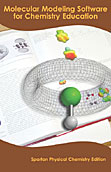|
Kombiniert Spartans einfach zu verwendende Benutzeroberfläche mit Berechnungsmöglichkeiten auf Forschungsniveau, wie Hartree-Fock Molecular Orbital, Density Functional Theory (DFT), und Møller Plesset (MP2). In Zusammenarbeit mit Q-Chem.
|
|
|
The Graphical User Interface. Spartan Student Physical Chemistry Edition has a single, fully-featured GUI that many consider to be the best in the business. The Student Version GUI is based on the easy to use Spartan'04 interface. In very little time, you can build and manipulate molecules, run molecular mechanics and quantum chemical calculations, and display results in text output, tabulated spreadsheet and plots, and in graphical form.
|
Organic
|
Accesses a builder for common organic fragments (e.g., "sp3 carbon"), functional groups and rings for easy construction of organic molecules.
|
|
Inorganic and Organometallic
|
Extends building throughout the Periodic Table. Includes a library of common ligands.
|
|
Structure Refinement
|
Allows fast minimization inside the builders using MMFF94 molecular mechanics.
|
|
Transition States
|
Provides guess for transition states by pattern matching to an extensive library of precalculated structures. The user needs only to specify reactant(s) and "reaction arrows". The "fallback" is the linear synchronous transit method.
|
|
Student Spartan Molecular Database
|
A library of more than 1,000 commonly encountered molecules is included with the Spartan Student Physical Chemistry Edition. Automatically searched when building, available data includes: name, geometry, gas-phase energy, solvation energy (aqueous), frontier molecular orbitals, dipole moments, charges, surface area, volume, molecular weight and symmetry. Data is available at HF, DFT, and MP2 levels.
|
Computational Methods. Spartan Student Physical Chemistry Edition provides a targeted set of computational methods to address the needs of educators and students. All methods are easily accessed via Spartan's seamless graphical interface, putting real computational power at your fingertips.
|
Molecular Mechanics
|
Molecular mechanics is presently the only practical method for calculations on very large molecules. Molecular mechanics models may be applied to molecules containing up to 1,000 atoms. MMFF94 has been specifically parameterized to reproduce geometries and conformations of organic molecules.
|
|
Semi-Empirical Molecular Orbital
|
Semi-empirical models are the simplest of the quantum chemical schemes, and are useful for equilibrium and transition-state structure calculations. The semi-empirical method included in the Student Physical Chemistry Edition, PM3, has proven to be a reliable tool for geometry calculations on transition metal inorganic and organometallic compounds. Semi-empirical models are applicable to molecules containing up to 50 atoms. PM3 parameters for most transition metals are now available.
|
|
Hartree-Fock Molecular Orbital
|
Hartree-Fock models are ideal for structure, energy and property calculations, in particular for organic molecules. They are applicable to molecules containing up to 30 atoms. Three basis sets are included: 3-21G, 6-31G* and 6-311+G**.
|
|
Density Functional Theory (B3LYP)
|
Density functional models typically provide results of a quality comparable to conventional correlated models such as MP2, but with a computational time only slightly greater than that of Hartree-Fock models. As such, they are particularly useful for high-quality structure, energy and property calculations, including calculations on transition-metal inorganic and organometallic compounds. B3LYP models are supported for 6-31G* and 6-311+G* basis sets and for molecules containing up to 20 atoms.
|
|
Møller-Plesset (MP2)
|
MP2 is perhaps the simplest model to take reasonable account of electron correlation, and generally provides accurate descriptions of equilibrium structure, conformation and energetics of a variety of chemical reactions, including reactions where chemical bonds are broken. MP2 is supported for 6-31G* and 6-311+G** basis sets and for molecules containing up to 20 atoms.
|
|
|
